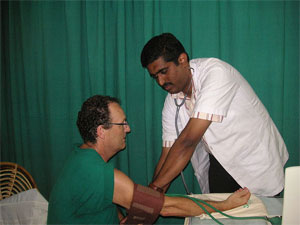Practitioner Diagnosis
 Let me first begin by stating that I am not an Ayurvedic Practitioner, therefore, the below
information is just for your knowledge and not meant to be used to diagnosis, treat, or
prevent illness. If you find that you are interested in this form of healthcare you can
learn more at www.niam.com or through various books on this topic.
Let me first begin by stating that I am not an Ayurvedic Practitioner, therefore, the below
information is just for your knowledge and not meant to be used to diagnosis, treat, or
prevent illness. If you find that you are interested in this form of healthcare you can
learn more at www.niam.com or through various books on this topic.
When an Ayurvedic Practitioner begins diagnosis of a disease they look at two main
areas; the history of the illness and examination of the patient. The history of the illness
refers to the following:
- Details of the symptoms, how, when, and where did they occur, duration of
medications taken, does anything make the symptoms better or worse
- Past history of similar illness, medicines taken, surgery, etc.
- Personal history, marriage, sexual life, family, occupational history, diet, sleep,
bowel movements, smoking, alcohol intake, drug use, living conditions,
financial status, social life, mental status
- Family history as well as illness and treatment
Next comes the exam of the patient. This is done in two steps.
- General exam: examination of the pulse, tongue, urine, stool, speech, gait,
general appearance, and exam of the constitution.
- Systemic exam: digestive, respiratory, circulatory, nervous, urinary, musculoskeletal,
reproductive, and integumentary systems
As you can see the exam is not much different from what we are used to seeing with
doctors. The Ayurvedic approach is known as a more holistic approach and takes into
account all components of a personʼs life from their work to the seasons to the time of
day to figure out what is wrong with the patient. It also focuses on the patientʼs dosha
and also is more in depth pulse examination.
- Practice by taking your own pulse -
This will be done by taking a radial pulse, or the pulse on the inside of your wrist.
Use the pads of three fingers and place them on the opposite wrist just below the base
of your thumb. Press lightly and then adjust pressure until you feel a throbbing
sensation. This is the pulse, which is the blood flowing through the arteries. Count how
many beats you feel in 60 seconds, this will be your heart rate. Normal heart rate is
between 60-100 bpm. In Ayurvedic medicine the fingers used to feel the pulse also
dictate the condition of metabolism, movement, and structure. The index finger is
associated with vaata, the middle finger represents pitta, and the ring finger is for
kapha. Which ever finger you get the forcible movement, the corresponding dosha is
said to be predominant.
There are many conditions that can change the rate, strength, and regularity of your
pulse. For example, certain medications, hypothyroidism, and heart conditions such as
heart block can cause an abnormally slow pulse (below 60 bpm) and anaemia,
hyperthyroidism, fever, low blood sugar, bronchodilators, lung disease, shock, liver and
kidney disorders, and heart ailments can cause a rapid pulse.
 Let me first begin by stating that I am not an Ayurvedic Practitioner, therefore, the below
information is just for your knowledge and not meant to be used to diagnosis, treat, or
prevent illness. If you find that you are interested in this form of healthcare you can
learn more at www.niam.com or through various books on this topic.
Let me first begin by stating that I am not an Ayurvedic Practitioner, therefore, the below
information is just for your knowledge and not meant to be used to diagnosis, treat, or
prevent illness. If you find that you are interested in this form of healthcare you can
learn more at www.niam.com or through various books on this topic.